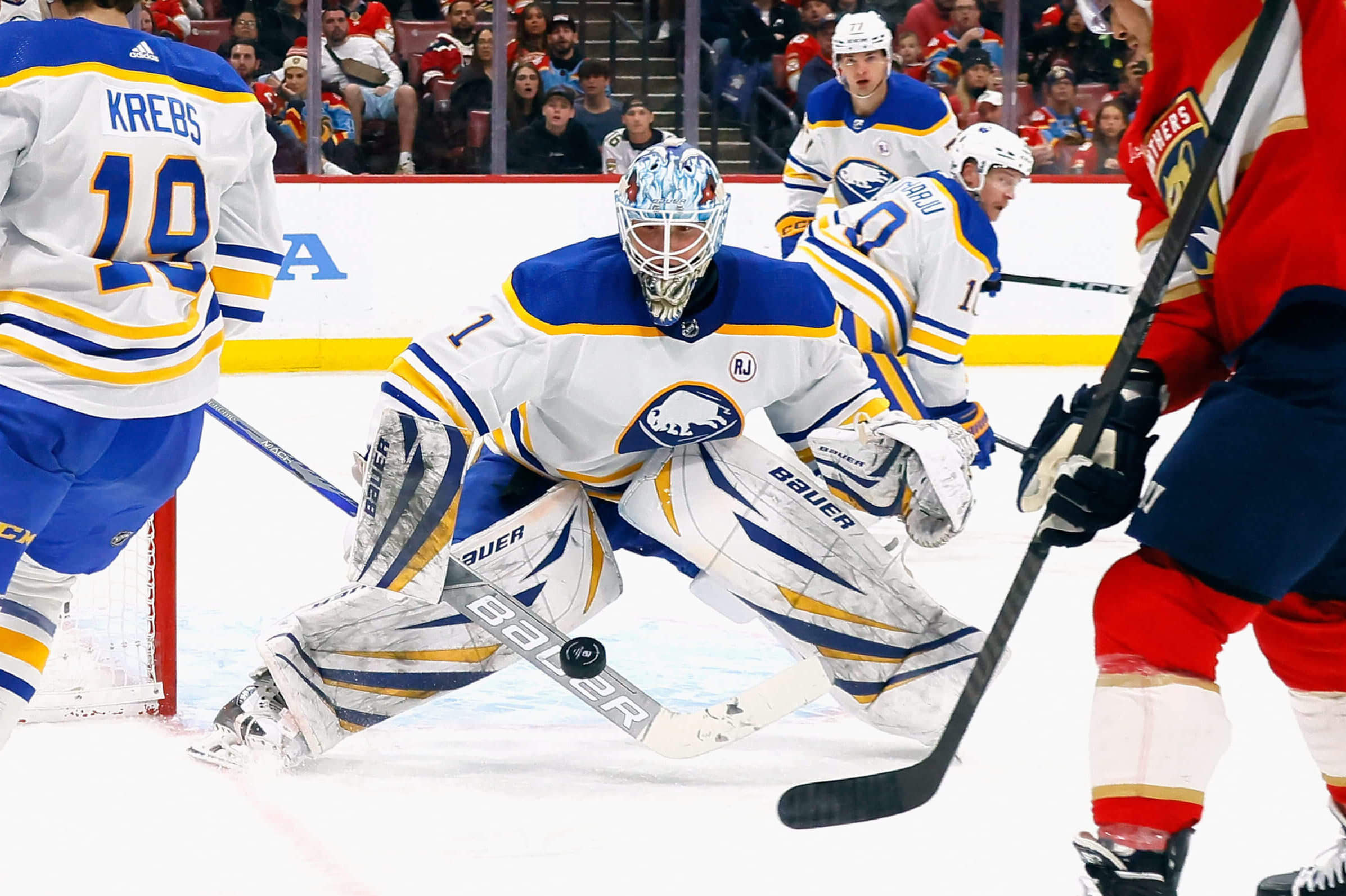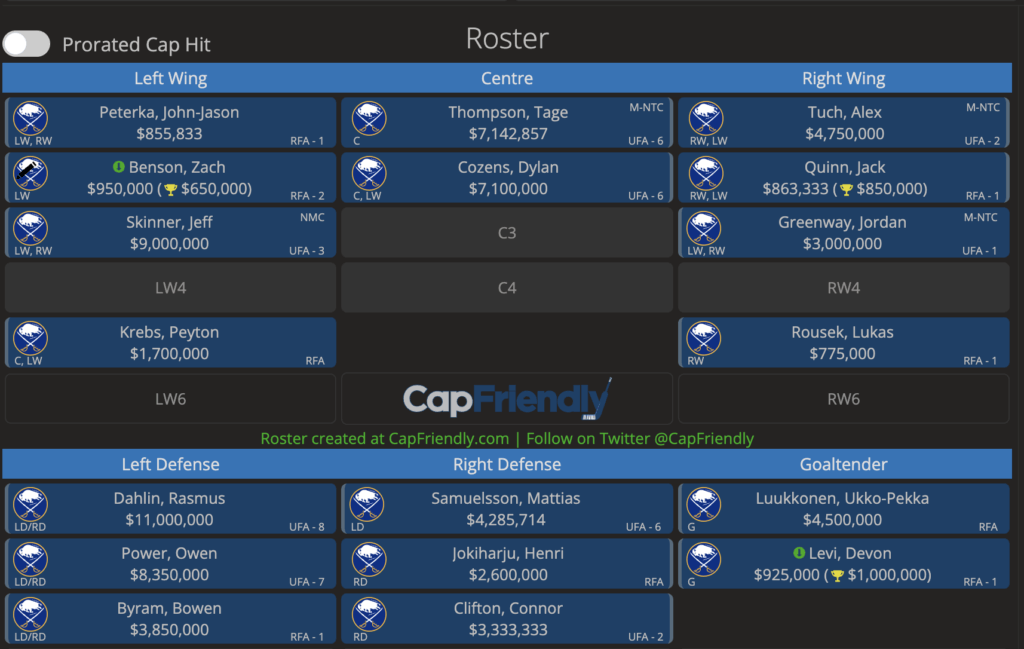
Sabres offseason roadmap, part 1: How much can Kevyn Adams spend?
How are the Sabres going to allocate their cap space, and how much will be left when factoring in their in-house spending?
Over the weekend, the NHL announced that the salary cap for the 2024-25 season will be $88 million, slightly higher than the initial projection. That means, according to CapFriendly, that the Buffalo Sabres will enter the summer with $23,518,930 in cap space and with 13 players under contract.
Throughout the next few days, we’re going to be going through the Sabres’ offseason road map piece by piece, starting with the salary cap and then moving on to potential trade targets and wrapping it up with a roster projection of moves we would make to fix the team. It’s both the most important and trickiest offseason for Kevyn Adams in his time as general manager. Some of that cap space will get eaten up by extensions, and Adams will need to bring in some new faces to give head coach Lindy Ruff the type of players he needs to round out Buffalo’s lineup.
We outlined some free-agent targets for the top six and bottom six earlier this offseason. But how are they going to allocate that cap space and how much will be left when factoring in their in-house spending?
Expired contracts: Zemgus Girgensons, Tyson Jost, Eric Robinson, Victor Olofsson, Eric Comrie
The Sabres have five unrestricted free agents and you could make an argument they don’t need to bring any of them back. Victor Olofsson is close to a sure bet to leave after a frustrating season spent in and out of the lineup. Tyson Jost and Eric Robinson didn’t do enough to warrant new contracts. Eric Comrie ended up as the odd-man out in the three-goalie rotation with Ukko-Pekka Luukkonen and Devon Levi. Adams had a lot of positive things to say about Zemgus Girgensons after the trade deadline, but he’s not a lock to return to Buffalo, either. The Sabres could use those five roster spots elsewhere.
Restricted free agents: Ukko-Pekka Luukkonen, Henri Jokiharju, Peyton Krebs, Jacob Bryson, Kale Clague
This is where the Sabres’ salary cap picture gets tricky. How many of these players will be back with Buffalo next season? Luukkonen is a lock, but his cap number is the question. Will he and the Sabres find common ground on an extension? The floor for him at this point seems to be the $3.75 million salary Filip Gustavsson signed last summer after a similar breakout season with the Wild. We will generously project Luukkonen at a $4.5 million cap hit on a four-year deal to account for the rising salary cap.
That brings us to Henri Jokiharju. The minimum qualifying offer for him is $2.6 million. That’s a comfortable price for what Jokiharju brings to the lineup, and the Sabres could always trade him after qualifying him if they receive interest from other teams.
The Sabres can probably afford to move on from Jacob Bryson and Kale Clague, given Ryan Johnson’s emergence as a solid depth option on defense. Between Rasmus Dahlin, Owen Power, Bowen Byram, Mattias Samuelsson, Connor Clifton, Jokiharju and Johnson, the depth chart is already crowded without accounting for any offseason additions.
Peyton Krebs should at least get an offer from the Sabres. Given his production last season, a contract with a cap hit between $1.5 million and $1.8 million seems reasonable. But he should also have to earn his way into a full-time role in the lineup.
Those three deals would cost the Sabres just under $9 million against the cap, leaving the team with between $14 million and $15 million for the remaining seven spots on the roster.
One of those roster spots will go to Devon Levi and his $925,000 cap hit. Another potentially could go to Johnson and his $925,000 hit, but he probably will end up going back and forth between the NHL and AHL. We’ll leave his spot open for the purpose of forecasting the cap, since he can still be sent down to the AHL without waivers.
What about the prospects?
The next step is determining if any of the prospects within the organization could fill a spot or two. Lukas Rousek will be a candidate in the final year of his contract, which carries a $775,000 cap hit. He works as a 13th forward and showed last season that he’s capable of filling a role. He forechecks hard and understands how to play away from the puck. Counting Rousek as part of the picture leaves just more than $13 million in cap space.Will any of Matt Savoie, Jiri Kulich, Isak Rosen or Noah Ostlund make the NHL? That could depend on what the Sabres do in the offseason. They shouldn’t be counting on more than one of those players to contribute to the NHL team next season. The roster is already young to begin with, and getting younger would be a risk Adams may not want to take in such a crucial season. Let’s assume these four prospects start the season in Rochester.

Offseason shopping
If you account for the Sabres having two goalies, seven defensemen (Johnson can serve as an eighth and stay in the AHL) and 14 forwards on the 23-man roster, the Sabres will have room to add one defenseman and up to four forwards, even with Krebs and Rousek in the picture. They would also have just over $13 million to spend on those pieces. Does that leave them enough room to add a top-six forward and revamp the bottom six while adding another experienced defenseman?It could, but they’re tighter against the cap that the $23 million figure indicates. If they add a big-money player via trade or free agency, that will limit their spending at the bottom of the roster. One way to manage that would be bringing up a prospect to fill a spot. Another would be to trade either Jokiharju, Krebs or both to provide some extra wiggle room under the cap. Either way, though, the Sabres shouldn’t have an issue with cap space, provided they are willing to spend closer to the cap than they have in recent seasons.
The other good news is that the salary cap is expected to rise again next summer, which will help the Sabres with possible future extensions. Peterka, Byram, Levi and Jack Quinn are all entering the final season of their contracts. Any additions that the Sabres make via trades and free agency will have to factor in those contracts that are coming down the line. But there’s no excuse for the Sabres to not make at least $10 million of additions this summer.
